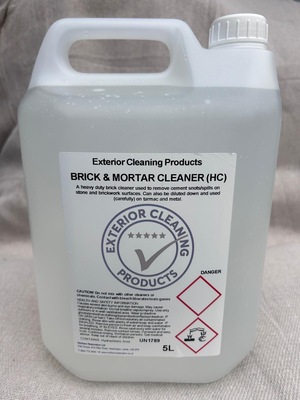Categories
Tags
Archives
Avoid Common Mistakes When Using Brick and Mortar Cleaners
-
Posted by Exterior Cleaning Filed in Shopping #Brick and Mortar Cleaners #Exterior Cleaning Products 80 views
When it comes to maintaining the beauty and integrity of your brick and mortar structures, using the correct cleaner is essential. Brick mortar cleaners are designed to tackle tough stains, debris, and weathering that can dull the appearance of your exterior surfaces. However, many homeowners make critical missteps during their cleaning process that can lead to unsatisfactory results or even damage. If you want to preserve your investment while achieving a pristine finish, understanding how to use these products correctly is key. Let's dive into some common mistakes people often make and explore how you can sidestep them for sparkling clean bricks! (Information Credited: https://exteriorcleaningproducts.com/product/brick-mortar-cleaner-hc/)
Common mistakes made when using brick-and-mortar cleaners
Using brick and mortar cleaners can be tricky. Many people make mistakes that lead to poor results or even damage.
One standard error is not understanding the type of brick or mortar being cleaned. Different materials require specific care, and using the wrong cleaner can cause discolouration or deterioration.
Another mistake is resorting to harsh chemicals or abrasive tools. These can strip away protective layers, leaving surfaces vulnerable to stains and weathering.
Neglecting proper area preparation is also a frequent oversight. Failing to clear debris or wetting the surface beforehand may hinder effectiveness, making it harder for cleaners to penetrate grime effectively.
Rushing through the cleaning process often leads to missed spots and uneven results. Taking your time ensures every crevice receives attention for a thorough clean.
Not all bricks and mortars are created equal. Each type can have unique properties that affect how it should be cleaned. Without this understanding, you risk damaging your surfaces.
For instance, softer brick types may require gentler cleaning methods to prevent wear and tear. Using a harsh cleaner on delicate materials can lead to discolouration or even crumbling.
Mortar composition also matters. Some mixes might be more porous than others, absorbing chemicals and stains easily. A one-size-fits-all approach can leave you with unsightly residue or damage.
It's essential to identify the specific materials used in your structure before reaching for any brick mortar cleaner. Doing so ensures a safe cleaning process that maintains the beauty of your exterior while prolonging its lifespan.
Using harsh chemicals or abrasive tools
Using harsh chemicals or abrasive tools can damage your brick and mortar surfaces. Many people assume that stronger products will yield better results, but this is often not the case.
Harsh cleaners can strip away protective layers and lead to discolouration over time. They may even cause erosion of the mortar joint, making repairs necessary sooner than expected.
Abrasive tools like wire brushes are effective for tough stains. However, they can scratch the surface of bricks, leaving them vulnerable to moisture penetration and further damage.
Instead of resorting to these aggressive methods, consider gentler alternatives designed explicitly for brick mortar cleaning. This approach preserves the integrity of your structures while ensuring a thorough clean without unnecessary risks.
Not properly prepping the area before cleaning
Prepping the area before using a brick mortar cleaner is crucial. Many overlook this step, thinking it's unnecessary. However, neglecting to prepare can lead to unsatisfactory results.
Start by removing any furniture or items nearby. This simple act creates space and prevents damage from splashes or spills. It also allows you to access all areas that need cleaning.
Next, sweep away dirt and debris from the surface. This helps avoid scratching the bricks during cleaning. Loose particles can become abrasive when mixed with cleaners.
Consider covering nearby plants or landscaping with tarps as well. Chemical runoff can harm vegetation if it is not managed correctly.
Check for cracks or damage in the mortar itself before starting your clean-up process. Addressing these issues first ensures you won't accidentally worsen them while scrubbing away grime later on.
Tips for avoiding these mistakes and achieving the best results
To achieve the best results with your brick mortar cleaner, start by identifying the specific type of brick or mortar you're dealing with. Each material has unique needs that dictate the cleaning approach.
Before applying any cleaner, always test it on a small, inconspicuous area first. This helps you see how the surface reacts without risking damage to larger sections.
Preparation is key. Remove loose dirt and debris from the surface before cleaning. A soft brush or broom can work wonders here.
When selecting your tools, opt for non-abrasive options like soft-bristle brushes or microfiber cloths. Harsh scrubbing can scratch surfaces and diminish their appearance.
Follow manufacturer instructions closely when using products from Exterior Cleaning Products Ltd. Adhering to guidelines ensures optimal performance and safety for your materials while enhancing longevity in your brick-and-mortar structures.
Conclusion
Maintaining brick and mortar structures is essential for their longevity and appearance. Proper cleaning techniques help prevent the deterioration of these materials, ensuring they remain both functional and aesthetically pleasing. Regular maintenance using the right brick mortar cleaner can protect against environmental damage, such as mould or mildew growth, which can compromise structural integrity.
Investing time in understanding your specific bricks and mortar will lead to better cleaning outcomes. Remember that proper preparation before any cleaning task sets the foundation for success. Choosing safe products like those from Exterior Cleaning Products Ltd not only enhances results but also safeguards your surfaces.
With careful attention to detail and an informed approach, you can keep your brickwork looking its best for years to come. A proactive attitude towards maintenance now saves considerable effort later on — making it easier to enjoy your beautiful brick-and-mortar structures long into the future.





